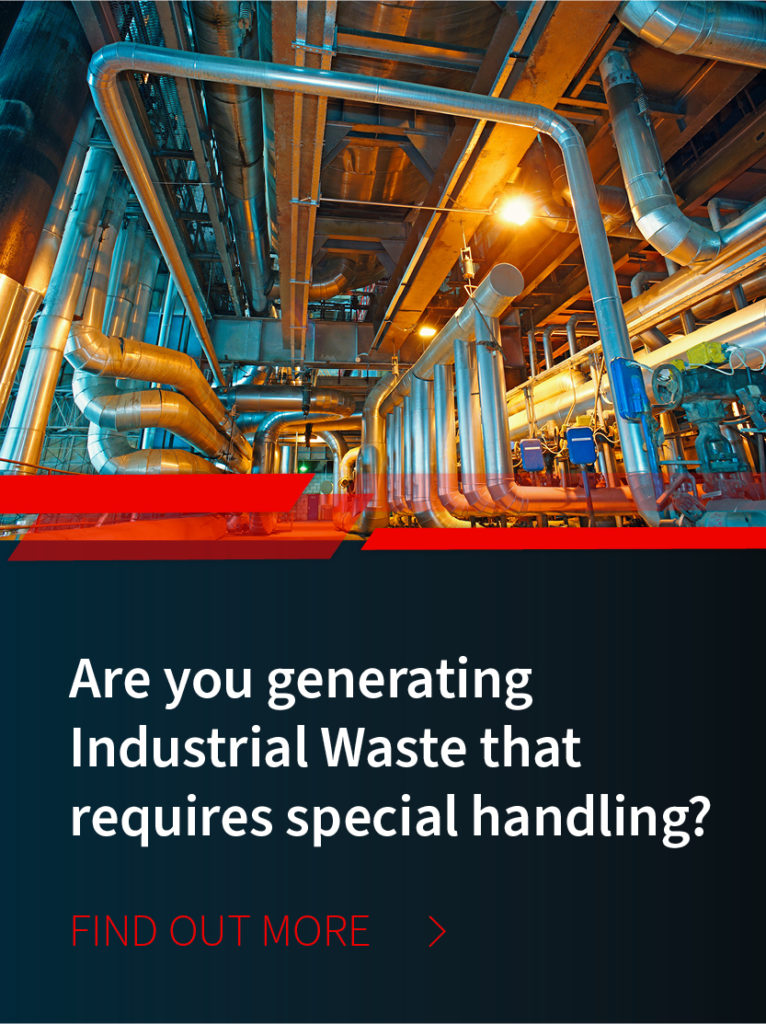
/ IN THIS BLOG
01 / Terminology surrounding industrial solid waste
As we’ve written about previously, one of the most confusing categories of hazardous waste management is what’s called “industrial waste” and sometimes referred to as “manufacturing waste.”
Herein, we opt for the former, industrial waste. But if you check the EPA’s official glossary, you’ll find neither “manufacturing waste” nor “industrial waste.” Look further, and you’ll bump into “industrial non-hazardous waste,” which is defined as:
“Waste generated from processes associated with the production of goods and products, such as electric power generation and manufacturing of materials such as pulp and paper, iron and steel, glass, and concrete.”
So you might think that when the EPA speaks to industrial waste, they’re talking about something that’s non-hazardous, per their own nomenclature. But the literature is rife with casual references to “industrial waste” that includes solids contaminated with oils, solvents, and chemicals that are very much hazardous.
Fact is, when people throw around the term “industrial waste,” they’re likely including hazardous wastes: materials that better not show up in your municipal waste stream.
For example, concrete is an industrial solid waste that doesn’t require hazardous waste management. But dust from grinding concrete requires special handling per something called OSHA Table I Compliance, which lists rules about occupational exposures to “respirable crystalline silica in construction work.”
Other industrial wastes that might require special handling are antifreeze, ash, grinding dusts, sludges, and/or liquids contaminated with non-hazardous chemicals.
Another caveat: Listed wastes are sometimes referred to as “industrial wastes,” which is definitely incorrect. Waste that comes from a factory might be “industrial waste,” loosely speaking as mentioned above. But if it’s actually a listed material, then it’s a “hazardous waste.”
So as we’re prone to advise: it’s important to get expert advice.
02 / Which solid materials in your industrial waste stream require hazardous waste disposal?
Some problematic examples of industrial solid wastes are oil-contaminated materials, paint residues, tires, and electrical components. Also included are food waste, animal remains, empty chemical containers, and infectious wastes.
Since these industrial solid wastes can be hazardous, it’s important that you analyze the different types of raw materials that input your manufacturing processes and operations, as well as what kinds of wastes they create.
This information, obviously, is crucial for keeping hazardous materials out of your non-hazardous waste streams, which you’re bound to do by force of law. But it also has a considerable budgetary benefit:
Mix a pound of benign waste with a pound of hazmat, and you’ll get two pounds of hazmat, doubling your hazmat disposal costs. So, ensuring that only what’s truly hazardous enters your hazmat stream is a prerequisite to controlling your hazardous waste disposal expenses.
03 / What are the different kinds of solid industrial waste?
Things like paper, plastic, wood, cardboard, packaging materials, and scrap metal are paradigms of what the EPA means by “industrial non-hazardous waste,” if they’re not contaminated with hazardous waste.
But chemical wastes are sometimes referred to as industrial solid wastes. These easily can be substances listed as hazardous by the EPA, or might be considered so for being “characteristically” ignitable, corrosive, toxic, reactive, or explosive.
Another complication surrounding industrial solid waste is that it can contain “liquid wastes” that are semisolid (e.g., fats, oils, greases, and sludges that might or might not be hazardous). Industrial processes typically require large amounts of water, which might become contaminated with hazardous materials like these. In such cases, a business or factory must apply wastewater treatment prior to the water’s discharge into the local treatment plant.
04 / The importance of proper industrial solid waste disposal
Waste management has become a major component of industrial operations since enactment of the RCRA 50+ years ago. This not only impacts your company’s bottom line in terms of hazardous waste-management cost. A constantly expanding raft of changeable RCRA regulations also poses significant legal and pecuniary risks.
05 / Get the best expert advice about industrial solid waste
MCF Environmental Services is one of the nation’s most trusted and respected waste disposal companies, with special expertise across all types of industrial waste, whether hazardous, non-hazardous, or non-hazardous requiring special handling.
Our team of industrial waste experts will partner with you to analyze the types of waste you’re generating, thereby providing expert advice on containerization, storage, transportation, and disposal requirements.
We offer unparalleled expertise disposing of all types of industrial waste, including hazardous and non-hazardous liquids, sludges, solids, and rags; RCRA metals for stabilization (D-list Solids); chlorinated liquids; acids; and more.
Robert Losurdo
President, COO








